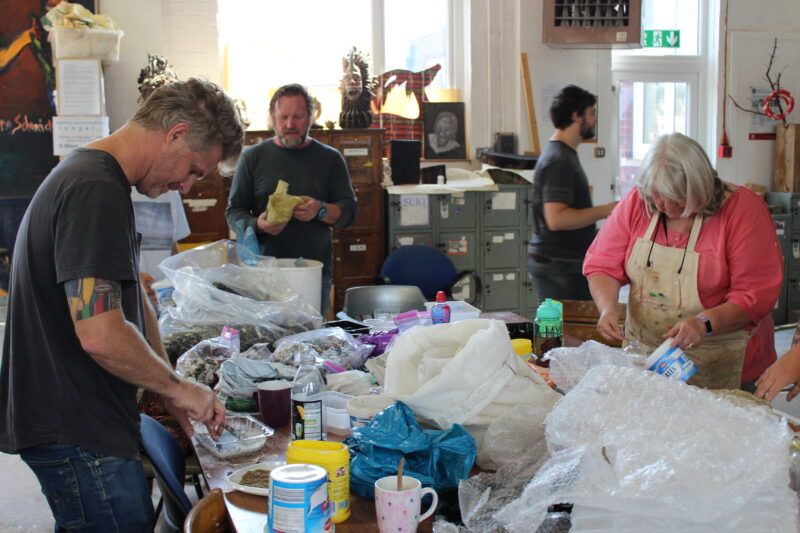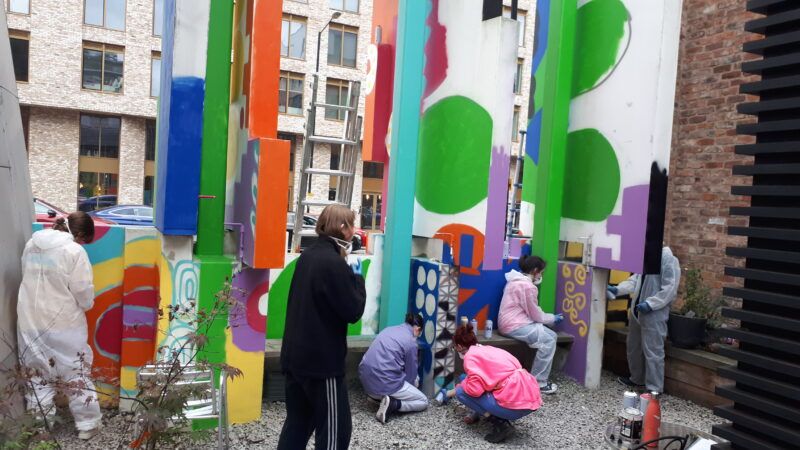There might be lots of reasons why people want to get more involved after initially joining an arts for mental health group or project – to develop new-found interests and skills as artists; perhaps they’ve found an important community; and hopefully because participating has become an important part of managing their mental health.
With the help of these five brilliant organisations – 42nd Street, Arc Stockport, Creative Shift, the New Note Orchestra for people recovering from addictions and North Tyneside Art Studio, this blog looks at how organisations respond to the personal and artistic development needs and aspirations of participants, focusing on four themes:
- Follow-on creative activities
- Other organisational roles, such as volunteers, mentors or peer support
- Independent creative practice
- Training to be artist/facilitators
Progression to follow-on creative opportunities
The social connectedness that creative groups (and other groups) can provide is often part of the magic. In fact, a review we supported in 2021 of the impact of creativity on people with severe mental illness referred to the ‘alchemy’ of participatory arts and highlights ‘social connectedness’ as a key ingredient in the cauldron (leading to hope and the possibility of recovery and wellbeing).
At the same time, demand is high, and space and resources can be limited. How do you create both community and opportunities for new and existing participants?
Both Arc Stockport and North Tyneside Art Studio note that people used to stay with them for a very long time. They have now both moved to a slightly different model, whereby there is more focus on people growing in independence over time. Arc’s initial programme is followed by a programme called ‘Creative Challenge’, which is tailored to each participant. Their Wellbeing Support Worker talks to people about their ‘next steps’ at each stage. From here there are other opportunities (see below).
Creative Shift is an arts on referral programme in Bristol, with a core offer of three six-week terms. Over time, they have developed a patchwork of follow-on routes. These include partnerships with for example the Bristol Museums Service which hosts a fortnightly follow-on group at their M-Shed venue. Making connections with big institutions is important in itself. Many people they work with don’t come into the city centre and museums and art galleries can seem austere and ‘not for them’. Holding workshops here can help people feel it is their space too.
Due to limited resources, one of Creative Shift’s follow-on groups has monthly visits from an artist and is participant-run other weeks. Another takes place at the same time and place as the initial programme, in a separate area of the venue, so some support remains to hand. They have experimented with peer-led follow-on groups but generally found these hard to sustain.
Progression to artist/workshop facilitator
Most of the organisations we spoke to have had some participants in the past who have gone on to lead workshops themselves either for their organisation or elsewhere. You can read a great blog here by Anne Johnson, a textile artist and tutor, whose career began at North Tyneside Art Studio.
However, there can be challenges. Arc noted that while if participants volunteer, they can continue to access mental health support from their Wellbeing Support Worker; as staff, they can’t. Dependability may also be an issue of someone’s mental health is fluctuating.
At NTAS, participants who have led workshops can then be seen by other participants as more akin to ‘staff’, with an expectation that they could fix things or that others could ask them for help during their own studio time. Now, they have a practice of encouraging ‘skill-sharing’, including demos or lightly facilitated craft sessions. They will also potentially try to match people up with other local organisations.

42nd Street and New Note have taken a more formalised approach.
As a youth organisation, 42nd Street are naturally aware that many young people who come to them might be interested in a career in the creative industries. Their Creative Collective for 18-25 year olds offers members a range of opportunities including facilitating a workshop and taking up commissions. They also run a programme called Ten by Ten – in which ten young people are each linked up with an artist and the pair then work collaboratively on a piece of artwork. The programme gives young people an insight into the working life of a freelance artist.
Last year, the New Note Orchestra ran a pilot programme called New Note Key Changers, whereby three orchestra musicians did five days training on workshop facilitation and then facilitated six sessions each in different Brighton venues, including a homeless hostel and a rehab centre. They describe the experience for trainees as transformative, with real changes in how people saw themselves. Interestingly, the ideas of ‘giving back’ and ‘service’ are key elements in recovery from addictions, so this opportunity really resonated with participants. They hope to run the programme again, with more training and more musicians. Additionally, the Orchestra is quite a closed group (you only need so many double basses!) and people tend to stay for a long time. New Note hopes that by training up the musicians they could open up more opportunities in Brighton for more people in recovery to have a similarly enriching experience.
Progression to other roles (volunteers, peer support etc)
As Creative Shift and New Note both noted, many people volunteer naturally. They want to help out whether that’s with setting up sessions or making tea.
However, Arc Stockport and 42nd Street have developed more formalised structures for volunteering in artistic and non-artistic roles.
After participant feedback that many wanted to volunteer at Arc, but didn’t know how, Arc has recently set up a pilot volunteer programme called Aspire. Aspire sessions focus on confidence-building (calming techniques, standing up in front of people, posture, talking about yourself), as well as creative facilitation (designing an activity and supporting an activity in a team). The programme concluded with a live event, during which volunteers could practise their skills. Most of the pilot cohort have gone on to volunteer, whether in sessions, or other roles in the café or shop.

42nd Street recently employed five interns, young people who used the service themselves and were mentored to support the Horsfall’s creative groups. They try to provide opportunities for young people to gain experience in youth work, research, counselling, as well as creative facilitation. 42nd Street note that while successful, the interns required more support than other staff into, during and out of these roles, and are considering how they create and fund this for future interns.
Progression into own/independent creative practice
At North Tyneside, they are highly aware that being an artist as a career is not necessarily good for a person’s mental health. Their ‘Next Steps’ course aims to support people who want to become artists, through topics such as how to cope with criticism, how to develop your own artistic interests, finding flow states, the importance of constantly challenging yourself as an artist, and the difference between making art for yourself and on a commercial basis.
While the logical progression from a visual arts studio like NTAS might be an independent studio space of your own, NTAS say that this is often financially prohibitive for people. As part of the Next Steps course above, however, they talk about how to set up a creative space at home, which might be more achievable.
Arc Stockport run a group called Creative Enterprise for participants nearing the recovery end of their time with Arc, which makes products for Arc’s shop. Participants learn a lot of skills, without the pressure of being a solo ‘maker’, whilst also getting an insight into the life of a maker (and how hard it can be!). To sustain the group, Arc hope that the group will become more of a team, with participants becoming peer mentors to new members and taking the lead on various projects.
Conclusions/reflections
Here are some parting thoughts, loosely one per theme.
- How do you create a stable community that helps people stay socially connected and well – yet also create opportunities for new participants? All of these organisations are doing that in different ways and being creative on little resource; yet it’s not easy – we need more of it and them!
- Many artists/facilitators in this field have lived experience; some were perhaps once participants too. Is this ‘system’ working? Are there sufficient opportunities? James Leadbitter (aka The Vacuum Cleaner) has written about lived experience leadership in arts and mental health here.
- Does the wider health and social care system sufficiently recognise the contribution that arts organisations make to help people to stay well or better, regain independence, find new skills and interests, get back into work and so on?
- Last and definitely not least, it is important to mention Outside In which supports visual artists who experience barriers, including mental ill-health, to become professional artists, promote and sell their work. What about other art forms?